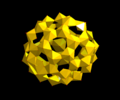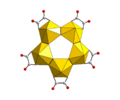Chemistry:Uranyl peroxide

| |
| Identifiers | |
|---|---|
3D model (JSmol)
|
|
| ChemSpider | |
| EC Number |
|
PubChem CID
|
|
| UNII | |
| UN number | 2909 |
| |
| |
| Properties | |
| UO4·nH2O | |
| Molar mass | 302.03 g/mol (as UO4) |
Except where otherwise noted, data are given for materials in their standard state (at 25 °C [77 °F], 100 kPa). | |
| Infobox references | |
Uranyl peroxide or uranium peroxide hydrate (UO4·nH2O) is a pale-yellow, soluble peroxide of uranium. It is found to be present at one stage of the enriched uranium fuel cycle and in yellowcake prepared via the in situ leaching and resin ion exchange system. This compound, also expressed as UO3·(H2O2)·(H2O), is very similar to uranium trioxide hydrate UO3·nH2O. The dissolution behaviour of both compounds are very sensitive to the hydration state (n can vary between 0 and 4). One main characteristic of uranium peroxide is that it consists of small needles with an average AMAD of about 1.1 μm.
The uranyl minerals studtite, UO4·4H2O, and metastudtite, UO4·2H2O, are the only minerals discovered to date found to contain peroxide. The product is a light yellow powder.
Synthesis
In general, uranyl peroxide can be obtained from a solution of uranium (VI) by adding a peroxide, usually hydrogen peroxide solution. The dihydrate is obtained from a boiling solution of uranyl nitrate with the addition of hydrogen peroxide and drying of the precipitate, while the trihydrate is precipitated from a solution of ammonium uranyl oxalate.[1]
Crystal structure
The unit cell consists of uranyl cations coordinated to two water molecules and two peroxide anions. The latter are μ2-coordinated to the cation—that is, end-on. Additional water molecules are bound in the crystal by hydrogen bonding.[2] Only the tetrahydrate has been characterized by X-ray crystallography, but density functional theory offers a good approximation to the dihydrate.[3]
Polyperoxouranylate allotrope
When uranyl nitrate is dissolved in an aqueous solution of hydrogen peroxide and an alkali metal hydroxide, it forms cage clusters akin to polyoxometalates or fullerenes.[4] Syntheses also typically add organic materials, such as amines, to serve as templates, akin to zeolites.[5]
A 50-uranium-atom peroxouranate cluster[4]
Peroxide-bridged uranyl dimers in K6(H2O)4[(UO2)2(O2)(C2O4)4][5]
Pentagonal oxaloperoxouranates in K10[(UO2)(C2O4)]5(H2O)13[5]
Applications
Radiolysis of uranium salts dissolved in water produces peroxides; uranyl peroxide has been studied as a possible end component of spent radioactive waste.[6]
References
- ↑ Rabald (1954). "Handbuch der präparativen anorganischen Chemie. Unter Mitarbeit zahlreicher Fachleute herausg. v. G. Brauer. Stuttgart: Ferdinand Enke Verlag 1954. XIX, 1439 S., 318 Abb., Ln. DM 199,—" (in en). Materials and Corrosion 5 (11): 475–476. doi:10.1002/maco.19540051117. ISSN 1521-4176. https://onlinelibrary.wiley.com/doi/abs/10.1002/maco.19540051117.
- ↑ Burns, Peter C.; Hughes, Karrie-Ann (2003). "Studtite, [(UO2)(O2)(H2O)2](H2O)2: The first structure of a peroxide mineral". American Mineralogist (Mineralogical Society of America) 88 (7): 1165–1168. doi:10.2138/am-2003-0725. Bibcode: 2003AmMin..88.1165B. (abstract; 39 kB PDF.)
- ↑ Weck, Philippe F.; Kim, Kim; Jové-Colón, Carlos F.; Sassani, David C. (2012). "Structures of uranyl peroxide hydrates: a first-principles study of studtite and metastudtite". Dalton Transactions 41 (32): 9748–9752. doi:10.1039/c2dt31242e. PMID 22763414. https://zenodo.org/record/1230018.
- ↑ 4.0 4.1 Forbes, Tori Z.; McAlpin, J. Gregory; Murphy, Rachel; Burns, Peter C. (2008). "Metal-Oxygen Isopolyhedra Assembled into Fullerene Topologies". Angew. Chem. Int. Ed. 120 (47): 2824–2827. doi:10.1002/ange.200705563. Bibcode: 2008AngCh.120.2866F.
- ↑ 5.0 5.1 5.2 Sigmon, Ginger E.; Jie Ling; Unruh, Daniel K.; Moore-Shay, Laura; Ward, Matthew; Weaver, Brittany; Burns, Peter C. (2009). "Uranyl-Peroxide Interactions Favor Nanocluster Self-Assembly". J. Am. Chem. Soc. 131 (46): 16648–16649. doi:10.1021/ja907837u. PMID 19919139.
- ↑ Nilsson, Sara; Jonsson, Mats (2011). "H2O2 and radiation induced dissolution of UO2 and SIMFUEL pellets". Journal of Nuclear Materials 1-3 (410): 89–93. doi:10.1016/j.jnucmat.2011.01.020. Bibcode: 2011JNuM..410...89N.
- Some Chemistry of Uranium
- Freeman, Marvin D.; Stover, Dennis E. (1999). "The Smith Ranch Project: a 1990s In-situ Uranium Mine". The Uranium Institute Twenty Fourth Annual International Symposium. The Uranium Institute. http://www.world-nuclear.org/sym/1999/freeman.htm.
- Kubatko, K. -A. H.; Helean, K. B.; Navrotsky, A.; Burns, P. C. (2003). "Stability of Peroxide-Containing Uranyl Minerals". Science 302 (5648): 1191–1193. doi:10.1126/science.1090259. PMID 14615533.
 |




